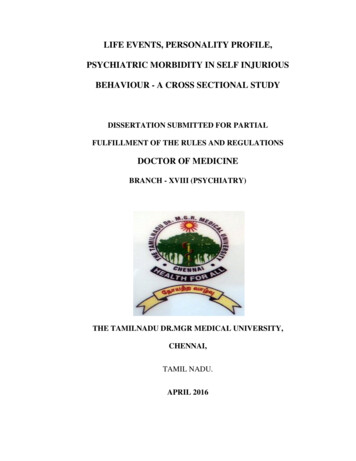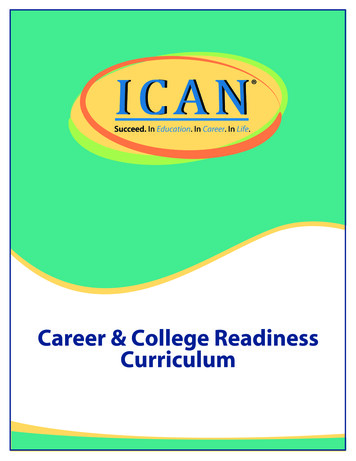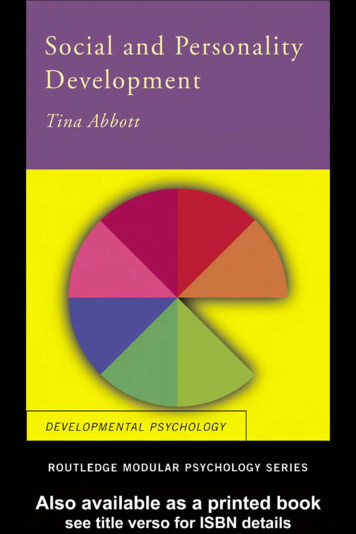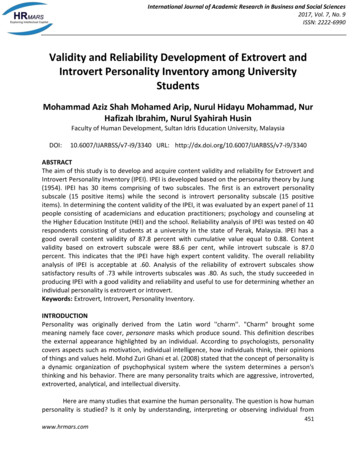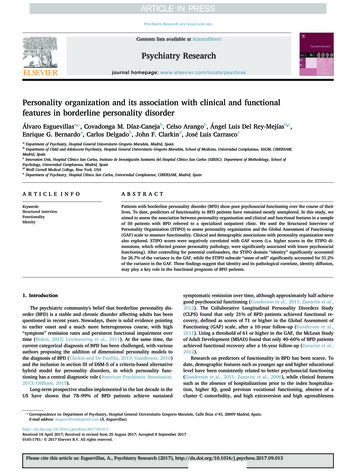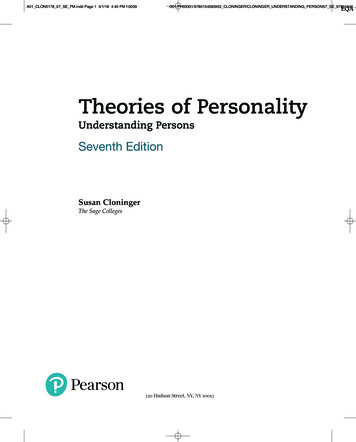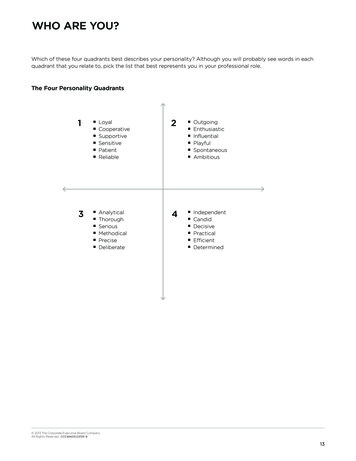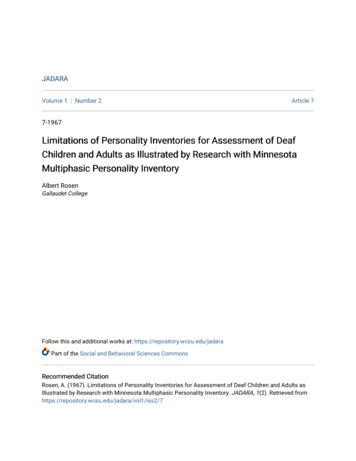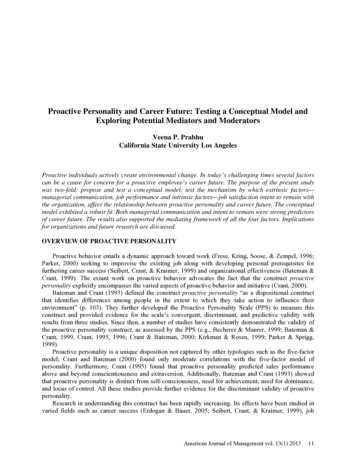
Transcription
Proactive Personality and Career Future: Testing a Conceptual Model andExploring Potential Mediators and ModeratorsVeena P. PrabhuCalifornia State University Los AngelesProactive individuals actively create environmental change. In today’s challenging times several factorscan be a cause for concern for a proactive employee’s career future. The purpose of the present studywas two-fold: propose and test a conceptual model; test the mechanism by which extrinsic factors—managerial communication, job performance and intrinsic factors—job satisfaction intent to remain withthe organization, affect the relationship between proactive personality and career future. The conceptualmodel exhibited a robust fit. Both managerial communication and intent to remain were strong predictorsof career future. The results also supported the mediating framework of all the four factors. Implicationsfor organizations and future research are discussed.OVERVIEW OF PROACTIVE PERSONALITYProactive behavior entails a dynamic approach toward work (Frese, Kring, Soose, & Zempel, 1996;Parker, 2000) seeking to improvise the existing job along with developing personal prerequisites forfurthering career success (Seibert, Crant, & Kraimer, 1999) and organizational effectiveness (Bateman &Crant, 1999). The extant work on proactive behavior advocates the fact that the construct proactivepersonality explicitly encompasses the varied aspects of proactive behavior and initiative (Crant, 2000).Bateman and Crant (1993) defined the construct proactive personality “as a dispositional constructthat identifies differences among people in the extent to which they take action to influence theirenvironment” (p. 103). They further developed the Proactive Personality Scale (PPS) to measure thisconstruct and provided evidence for the scale’s convergent, discriminant, and predictive validity withresults from three studies. Since then, a number of studies have consistently demonstrated the validity ofthe proactive personality construct, as assessed by the PPS (e.g., Becherer & Maurer, 1999; Bateman &Crant, 1999, Crant, 1995, 1996; Crant & Bateman, 2000; Kirkman & Rosen, 1999; Parker & Sprigg,1999).Proactive personality is a unique disposition not captured by other typologies such as the five-factormodel; Crant and Bateman (2000) found only moderate correlations with the five-factor model ofpersonality. Furthermore, Crant (1995) found that proactive personality predicted sales performanceabove and beyond conscientiousness and extraversion. Additionally, Bateman and Crant (1993) showedthat proactive personality is distinct from self-consciousness, need for achievement, need for dominance,and locus of control. All these studies provide further evidence for the discriminant validity of proactivepersonality.Research in understanding this construct has been rapidly increasing. Its effects have been studied invaried fields such as career success (Erdogan & Bauer, 2005; Seibert, Crant, & Kraimer, 1999), jobAmerican Journal of Management vol. 13(1) 201311
performance through a social capital perspective (Thompson, 2005); transformational (Bateman & Crant,1993) and charismatic leadership (Crant & Bateman, 2000); and job search success (Brown, Cober, Kane,Levy, & Shalhoop, 2006). Chan (2006) has explored the interactive effects of situational judgmenteffectiveness and proactive personality on work perceptions and outcomes. Parker and Sprigg (1999)found that proactive personality moderated the interactive effect of job autonomy and demands onemployee strain. Their results were consistent with the premise that proactive employees take advantageof high job control to manage the demands they face more effectively, whereas passive employees do nottake advantage of greater autonomy to this end.Proactive Personality and Career FutureAn idea that has recently gained much ground is the notion that work design does not simply allowemployees to apply knowledge they possess, but it also promotes knowledge creation, or employeelearning and development. Research suggests that individual characteristics may be the strongestpredictors of engagement in development activity (Maurer & Tarulli, 1994). Evidence is accumulating forthis more developmental perspective. Studies have shown a link between the greater use of personalinitiative (Frese, Kring, Soose, & Zempel, 1996) and the development of more proactive role orientations(Parker, Wall, & Jackson, 1997). This learning and developmental perspective is consistent with theGerman Action Theory (e.g. Hacker, Skell, & Straub, 1968) which is based on the ideology that work isaction-oriented. More broadly, Action Theory is substantiated by the premise that: “the human is seen asan active rather than a passive being who changes the world through work actions ” (Frese & Zapf,1994; p. 86).People are not always passive recipients of environmental constraints on their behavior; rather, theycan intentionally and directly change their current circumstances (e.g., Buss, 1987; Diener, Larsen, &Emmons, 1984). In dynamic circumstances which tend to be less well-defined, it is reasonable to assumethat individuals might mold their work characteristics to fit their individual abilities or personalities.People with a proactive personality are relatively unconstrained by situational forces (Bateman & Crant,1993). Readiness and determination to pursue a course of action are characteristic of proactive peoplewhich are also central to models of self-development (Antonacopoulou, 2000).The words of Bateman and Crant (1999) capture the essence of proactive personality.Proaction involves creating change, not merely anticipating it. It does not just involve theimportant attributes of flexibility and adaptability toward an uncertain future. To beproactive is to take the initiative in improving business. At the other extreme, behaviorthat is not proactive includes sitting back, letting others make things happen, andpassively hoping that externally imposed change “works out okay.” (p. 63)Careers have changed dramatically with advances in technology (Coovert, 1995; Freeman, Soete, &Efendioglu, 1995; Howard, 1995; Van der Spiegel, 1995) and increased global competition (Rosenthal,1995). Thus in today’s borderless world characterized by technological advances wherein companies arecompeting for survival the assumption that an organization would provide lifetime employment hasundoubtedly become a myth—‘both parties know that the [employment] relationship is unlikely to lastforever’ (Cappelli, 1999, p. 3) which in turn demands that employees start charting and navigating theircareers. Thus there is renewed interest in the idea of individuals taking responsibility for their career withresearchers investigating the effect of various factors on careers (e.g., Sullivan, Carden, & Martin, 1998).In the present study we have concentrated on the construct of career future because in today’s competitiveenvironment individuals are bound to be concerned about their job security and whether they anticipate‘to climb the ladder’ if they continue to work for the same organization. Although the extant literaturelacks an appropriate definition for the construct of career future, in the present study it has beenoperationalized as an employee’s belief about having prospects for career advancement in the presentorganization.12American Journal of Management vol. 13(1) 2013
Conceptual Model of Proactive Personality and Career FutureCampbell (2000) pointed out the possibility of proactive persons receiving negative reactions fromthe organization, and raised an important question: “Are employees’ enterprising qualities trulyuniversally desirable, or do particular job and organizational circumstances make them relatively more orless valuable?” (p.57). Likewise, Frese and Fay (2001) proposed that there are limits to personal initiative,this is aptly termed by Campbell (2000) as the “initiative paradox”—where organizations on one handencourage proactivity but fail to make room for the probable pitfalls such as misguided proaction(Bateman & Crant, 1999). For example, if proactive employees are not convinced that their career wouldprosper if they continued at the same organization, they would proactively search for new employers andavenues. Losing these employees would cost the organization time and money and this would be viewedunforgivably by management. It is, therefore, of vital importance to gain insight into understanding themechanism by which proactive personality leads to career future. This entails investigating “how” or“why” (mediating effect) and “when” (moderating effect) does proactive personality lead to career futureand other job outcomes (Crant, 2000; Erdogan & Bauer, 2005). Trying to understand these relationshipsand based on the extant literature of careers lead to the development of a conceptual model of proactivepersonality and career future which included not only direct effects but also certain potential mediatingand moderating effects (See Figure 1).FIGURE 1PROPOSED CONCEPTUAL MODEL OF THE EFFECT OF PROACTIVEPERSONALITY ON CAREER FUTUREAmerican Journal of Management vol. 13(1) 201313
Potential Mediators and Moderators in the Relationship Between Proactive Personality and CareerFutureSeveral authors have noted that understanding the strategies and behaviors applied by individuals toachieve career success is of vital importance (Bell & Staw, 1989; Judge & Bretz, 1994). In today’scompetitive world where there has been an increasing emphasis on protean careers, boundaryless careers,and career self-management (Hall, 1996a, 1996b; Jackson, 1996; King, 2004) proactive personalityperfectly fits the bill. In an interesting study by Seibert, Crant, and Kraimer, (1999) proactive personalitywas associated with career success even after accounting for predictors, such as demographics, humancapital, motivation, type of organization, and type of industry. In another longitudinal study they alsofound proactive personality to be positively related to career initiative, which consequently has a positiveimpact on career progression and career satisfaction (Seibert, Kraimer, & Crant, 2001).However, it is essential to note that research on proactive career behavior primarily focused on‘bounded careers, that is, single-employer careers with the prospect of stable employment’ (Claes, &Ruiz-Quintanilla, 1998, p. 358). It would be appropriate to conclude that today’s environmentcharacterized by severe competition is the antonym of a stable environment. The recession has made theconcept of job security obsolete and thus shifted the responsibility from employers to employees (Hall &Mirvis, 1995). In such a backdrop it would be logical to assume that employees, especially proactiveemployees, would remain with the organization only if they were convinced that they do have a careerfuture in the organization. Thus in the present context it may be plausible that if the proactive employeesare not convinced that they have career future they may not only be proactive in leaving the job but alsosearching new jobs. Thus it is of vital importance to gain insight into understanding as to how proactivepersonality affects career future.Based on the extant literature four factors were chosen—two extrinsic (managerial communicationand job performance) and two intrinsic factors (job satisfaction and intent to remain with theorganization).Dual Role of Managerial Communication and Intent to Remain with the OrganizationWith the advent of globalization, companies are constantly evolving and actively changing to not onlysurvive but also thrive in this competitive environment. Managerial communication is a significant factorin employees’ support for change. It has gained importance in recent years as researchers have found it tobe predominantly vital in the entire organizational change process (Armenakis & Harris, 2002; Lewis,1999). It is generally defined in terms of a process through which companies basically prepare employeesfor change by stating and clarifying issues related to the change (Lewis, 1999). Communication helpsemployees to gain a better understanding for the need for change, as well as to have some insights on thepersonal effects that may have been caused by the proposed change (Armenakis & Harris, 2002). Theprocess perspective suggests that when employees receive adequate and suitable communication in achange context (i.e. appropriate justification for, and information about, the change and timely feedback),they will have more favorable attitudes toward the change which, in turn, provides them insights as to“how” and “when” their careers will be affected in the near future.Another important factor to consider is an employee’s intent to remain with the organization. Pastresearch has found career commitment as an important individual factor of turnover (Bedeian, Kemery &Pizzolatto, 1991; Cotton & Tuttle, 1986; Mobley, Griffeth, Hand, & Meglino, 1979; Price & Mueller,1981). Furthermore studies provided support for a significant inverse relationship between careercommitment and turnover (Bartol, 1979; Harrell, Chewning & Taylor, 1986).Additionally past research has studied career related factors as a predictor of turnover intentions.However, once an employee has decided that he/she intends to remain with the company for varyingreasons (personal or professional) intent to remain can also serve as a predictor. Jauch, Osborn andTerpening (1980) suggested several reasons for an employee’s intent to remain (or conversely turnoverintentions) with an organization. They pointed out that it is not only identification with the organizationbut it can also be identification with a specific career or a particular set of peers. Furthermore, earlierstudies suggested employees could be committed to either organizational or career goals but not both.14American Journal of Management vol. 13(1) 2013
Subsequently studies revealed commitment to neither, either, or both the career and the organization(Berger & Grimes, 1973). Additionally studies showed that individuals where able to achieve their needsby either merging their needs with organizational needs through participation (Latham & Yukl, 1975)and/or treat the organization as an instrument of his/her fulfillment (Rotondi, 1975). This suggests thatintention to remain with an organization can be achieved due to several reasons and if so can then serve asa predictor of career future. For example if an employee intends to stay with the company due to peerloyalty or personal reasons such dual career couples etc s/he will find different ways to ensure a careerfuture by using every opportunity the company provides.Hence, in the present study we propose and test that intent to remain acts as a predictor of careerfuture.The moderation framework refers to a situation that includes three or more variables, such that, thepresence of one of those variables changes the relationship between the other two, while in the mediationframework there is a causal process between all three variables. From the above discussion we anticipatethat managerial communication and intent to remain with the organization will act as both a mediator andmoderator.Hypothesis 1: Managerial communication will mediate the relationship betweenproactive personality and career future.Hypothesis 2: Managerial communication will moderate the relationship betweenproactive personality and career future.Hypothesis 3: Intent to remain with the organization will mediate the relationshipbetween proactive personality and career future.Hypothesis 4: Intent to remain with the organization will moderate the relationshipbetween proactive personality and career future.Job Performance and Job SatisfactionThe range of job-related outcomes usually considered in work design research has been criticized asbeing too limited. However, traditional outcomes such as job satisfaction (intrinsic) and job performance(extrinsic) will certainly remain central to the agenda; hence these two outcomes were chosen in thepresent study. Mainly, proactive personality has been related to extrinsic job-related outcomes such as jobperformance (Crant, 1995; Thompson, 2005), extrinsic career success, or actual advancements in salaryand position (Seibert, Crant, & Kraimer, 1999; Seibert, Kraimer, & Crant, 2001).Proactive personality has also been related to intrinsic career success, i.e. job and career satisfaction.Intrinsic success is also important because of its relation to life satisfaction (Lounsbury, Park, Sundstrom,Williamson, & Pemberton, 2004). In the present study job satisfaction was defined as an individual'sglobal feeling about his or her job (Spector, 1997). Dispositional characteristics incline people to a certainlevel of satisfaction (see Bowling, Beehr, Wagner, & Libkuman, 2005).Additionally several studies have provided evidence of the importance of job satisfaction in careers.For example the Career Attitudes and Strategies Inventory (CASI) developed by Holland and Gottfredson(1994) ‘‘provides an assessment of the likelihood of job stability or change’’ (p. 1). The CASI containnine scales—job satisfaction being one of them. Holland (1996, p. 402) found that people with stablework histories (i.e., remaining in the same career) ‘‘have high scores on the Job Satisfaction scales”. AlsoAlexander, Lichtenstein, Joo Oh, and Ullman (1998) surveyed 1106 nursing personnel and found that jobsatisfaction was negatively related to career change intent. Similarly, Smart and Peterson (1994) sampled498 professional women and found that job satisfaction was positively correlated with career persistence.Based on the above discussion we anticipated a meditational framework:Hypothesis 5: Job performance will mediate the relationship between proactivepersonality and career future.Hypothesis 6: Job satisfaction will mediate the relationship between proactivepersonality and career future.American Journal of Management vol. 13(1) 201315
METHODOLOGYResearch Setting and ParticipantsCross-sectional data were collected from employees who work in the private sector in Israel. Themain sectors represented in our sample are technology, pharmaceuticals, telecommunication, finance andaviation. The data were collected via a self-report online survey using the snow-ball effect. Surveyadministration process was initiated by sending an email information letter to 25 people in 14 privatesector companies in Israel, inviting them to participate in the research study. These initial respondentswere asked to disperse the survey to five other employees who worked with them in their company or toother workers in the private sector. The email cover letter contained the link to the survey and a requestnot to answer the survey if the recipient was not working in the private sector in Israel. Because English isa second language in Israel and is actively used and spoken in the country’s business community, thecontact email and the survey were distributed in the English language. Only employees with access toemail and the internet were able to receive and answer the survey. We collected 120 completed and usablesurveys.Prior to the data collection in Israel, a pilot study was conducted to test the reliability of the survey.The survey was distributed to 40 MBA students in a large, public university on the West Coast in theUnited States online via www.Zoomerang.com and in the classroom.In the Israeli sample the respondents had an average age of 30 years. Of the 120 people surveyed,about 54% were female. About 59% of respondents had a Bachelor degree, 27% had a Masters degree,and only 3% had a post graduate degree. Of the 120 respondents, 23% were software engineers, about17% customer service representatives, 15% sales and marketing people, about 8% human resourcemanagement people, 7% operations and logistics and about 6% in business development. Tables 1 and 2provide a demographic and job positions profile of the respondents, respectively.16American Journal of Management vol. 13(1) 2013
TABLE 1DEMOGRAPHIC PROFILE OF SURVEY 6651.662.55.833.33137133310.8359.1627.52.5Tenure ( Organization ) 1 year1-5 years6-10 years11-20 years 20 years1388118010.8373.339.166.660Tenure ( Job Position ) 1 year1-5 years6-10 years11-20 years 20 years179175014.1675.835.834.160Age20-29 years30-39 years40-49 years50-59 years 60 yearsEducationHigh SchoolBAMAHigher DegreeNote: N 120TABLE 1 (CONTINUED)POSITIONS WITH ORGANIZATIONVariableN%Job Position-Software Engineer-Manager-Sales/Marketing-Customer Service-Operations / Logistics-Human resources-Business .335.8315Note: N 120American Journal of Management vol. 13(1) 201317
MeasuresCareer FutureCareer future was measured by using a part of the Index of Organizational Reactions (IOR) scaledeveloped by Dunham and Smith (1979). The IOR assesses satisfaction with supervision, financialrewards, kind of work, physical conditions, amount of work, company identification, co-workers, andcareer future. Five items related to career future was used which were obtained from Cook, Hepworth,Wall, and Warr (1981, pp. 42-45). Several studies have used this scale reporting coefficient alpha valueswhich ranged from .82 to .83 (Lee & Johnson, 1991; McLain, 1995; Taylor, Tracy, Renard, Harrison, &Carroll, 1995). The present study reported a Cronbach’s alpha of .84.Proactive PersonalityProactive personality was measured by using the shortened version of Bateman and Crant's (1993)17-item Proactive Personality Scale (PPS) created by Seibert, Crant, and Kraimer, (1999). The shortenedversion consisted of 10 items which were selected as they had the highest average factor loadings acrossthe three studies reported by Bateman and Crant (1993). These three studies presented evidence for thescale’s reliability (Cronbach’s alpha across three samples ranged from .87 to .89, and the test-retestreliability coefficient was .72 over a 3 month period) and convergent, discriminant, and criterion validity.Seibert et al (1999) mentioned that the deletion of 7 items did not result in a major effect on the reliabilityof the scale (17-item α .88; 10-item α .86). These items were summed to arrive at a proactivepersonality score. Responses were indicated on a seven-point Likert scale ranging from 1 ("stronglydisagree") to 7 ("strongly agree"), with such items as "I excel at identifying opportunities" and "No matterwhat the odds, if I believe in something I will make it happen." Internal consistency (coefficient alpha)obtained in the current study was .89, in line with that reported by Bateman and Crant (1993).Managerial CommunicationManagerial communication was measured by using a subscale of the Communication SatisfactionQuestionnaire (CSQ) (Downs & Hazen, 1977). The CSQ is a 40-item instrument that has demonstrated ahigh degree of validity and reliability across a number of organizations, and in multiple contexts(Clampitt & Downs, 2004). Although several factors are identified by Downs and Hazen (1977) asindicators of overall communication satisfaction in the workplace, the focus of the present study wasspecifically related to the dimension that assesses employees’ satisfaction with communication with theirimmediate supervisor or manager. Specifically this dimension is identified as personal feedback in theoriginal instrument. It assesses how satisfied employees are with information they receive about their job,recognition of their efforts, and how well supervisors understand problems faced by employees. A 7-pointLikert response format (ranging from 1 very dissatisfied to 7 very satisfied) was used to measureemployees’ satisfaction to the five items. Previous studies that have assessed the internal consistency ofthe individual dimensions of the CSQ have reported coefficient alphas of .80 (Pincus, 1986) and .84(Crino & White, 1981) for the personal feedback dimension. A more recent study examining thepsychometric properties of the CSQ (Gray & Laidlaw, 2004) reported a coefficient alpha of .86 for thepersonal feedback dimension. The reliability found in the present study was in tune with these studies asCronbach’s alpha was .90.Job PerformanceJob performance was measured by using self-report scale which included 7 items and was a subset ofthe 20-item scale prepared by Williams and Anderson (1991). The Williams and Anderson (1991) scalewas originally validated on 127 employees working in varied organizations. Factor analysis resulted inthree distinct behavior factors—job performance being one of them. Example questions include “fulfillsresponsibilities specified in the job description” and “meets formal performance requirements of the job.”Items were summed to yield a total performance score for each employee. Reliability of the scale was inthe present study was .92.18American Journal of Management vol. 13(1) 2013
Job SatisfactionJob satisfaction was measured by using a nine item scale developed by Eisenberger, Cummings,Armeli and Lynch (1997). Respondents indicated the extent of their agreement with each item on a 7point Likert-type scale (1 strongly agree, 7 strongly disagree). Cronbach’s alpha measured for thisscale was α .94.Intent to RemainEmployee’s intent to remain with the organization was measured using a scale from Robinson (1996).This four-item scale asked employees to respond to Likert-type questions about how long the employeeintends to remain with the employer, the extent to which they would prefer to work for a differentemployer, the extent to which they have thought about changing companies, and one binary question (“Ifyou had your way, would you be working for this employer three years from now?”). We found a rathermodest reliability with Cronbach’s alpha measuring .68.Demographic Data and Control VariablesThe survey also included items inquiring about the subjects' age, gender, ethnicity, and job tenurewhich were used as control variables in the study. Gender was dummy coded 0 for female subjects and 1for male subjects. (See Table 1 for a summary of the measures).Data AnalysisData for this study were collected anonymously. Anonymity provided benefits by potentially reducingthe method bias (see Podsakoff, MacKenzie, Lee, & Podsakoff, 2003). Data were analyzed usingStructural Equation Modeling (SEM) implemented in AMOS and hierarchical regression analyses (See,Barron & Kenny, 1986). First the model fit was tested using several confirmatory factor analyses andcomparing the goodness of fit indices. SEM was used to validate the conceptual model. Both themeditational and moderational framework were tested using hierarchical regression analysis (See Aiken& West, 1991; Cohen, Cohen, West, & Aiken, 2003; Frazier, Tix, & Barron, 2004; Holmbeck, 1997).Tests for Model FitThe first step in the data analysis process involved running several confirmatory factor analyses andobserving the fit of the data by checking whether all the goodness-of-fit indices met the respectivecriteria.The goodness of fit of the models was evaluated by using absolute and relative indices. The absolutegoodness-of-fit indices which were calculated are (cf. Jöreskog & Sörbom, 1993) (a) the chi-squaregoodness-of-fit statistic and (b) the root-mean-square error of approximation (RMSEA). Although thechi-square likelihood ratio is considered the most fundamental measure of absolute model fit, it issensitive to sample size and thus, with larger sample sizes (more than 200), can result in significant valueseven when small differences exist between the model and the data (Anderson & Gerbing, 1988; Hair,Anderson, Tattham, & Black, 1998). The ratio of chi-square to degrees of freedom (χ2/df) has beensuggested as an alternative, with values of 2.0 or less indicative of acceptable fit (Kline, 2005). TheRMSEA is a measure of model discrepancy and takes into account the error of approximation in thepopulation (Hu & Bentler, 1999). The relative goodness-of-fit indices which were computed are (cf.Marsh, Balla, & Hau, 1996) (a) the normed fit index (NFI) (b) the comparative fit index (CFI), and (c) theincremental fit index (IFI). The CFI is a measure of fit derived from the comparison of the hypothesizedmodel to the independence model and adjusts for sample size. CFI values of 0.90 or greater are indicativeof acceptable models (Hu & Bentler, 1999).Hypothesis Testing: Mediating and Moderating EffectsIn the present study the data was analyzed by using hierarchical linear regression. To test formediation Barron and Kenny (1986) suggested a three-step procedure: 1) the mediator was regressed onthe independent variable, 2) the dependent variable was regressed on the independent variable, and finallyAmerican Journal of Management vol. 13(1) 201319
3) the dependent variable was regressed on both the independent variable and on the mediator. However,to test for complete mediation the independent variable needs to be controlled in the third step. Hence asimple regression was performed for step one, but for steps two and three a hierarchical linear regressionwas employed. A formal test of the significance of mediation was provided by the Sobel test (seeMacKinnon, Warsi, & Dwyer, 1995). Similarly for moderation, step 1 included only the IV-proactivepersonality and in step in addition to the moderator variable the interaction term was introduced. Asignificant interaction term provides support for the moderational framework. Following the regressionanalysis the slopes are calculated at low medium and high levels of the moderator variable.RESULTSDescriptive StatisticsTable 2 displays means, standard deviations and correlations among all the variables. Correlationsamong the independent and mediator variables had a median value of .19 and a maximum value of .33,with a maximum variance-inflation factor less than 2; hence, multicollinearity
Proactive personality is a unique disposition not captured by other typologies such as the five-factor model; Crant and Bateman (2000) found only moderate correlations with the five-factor model of personality. Furthermore, Crant (1995) found that proactive personality predicted sales performance above and beyond conscientiousness and extraversion.

